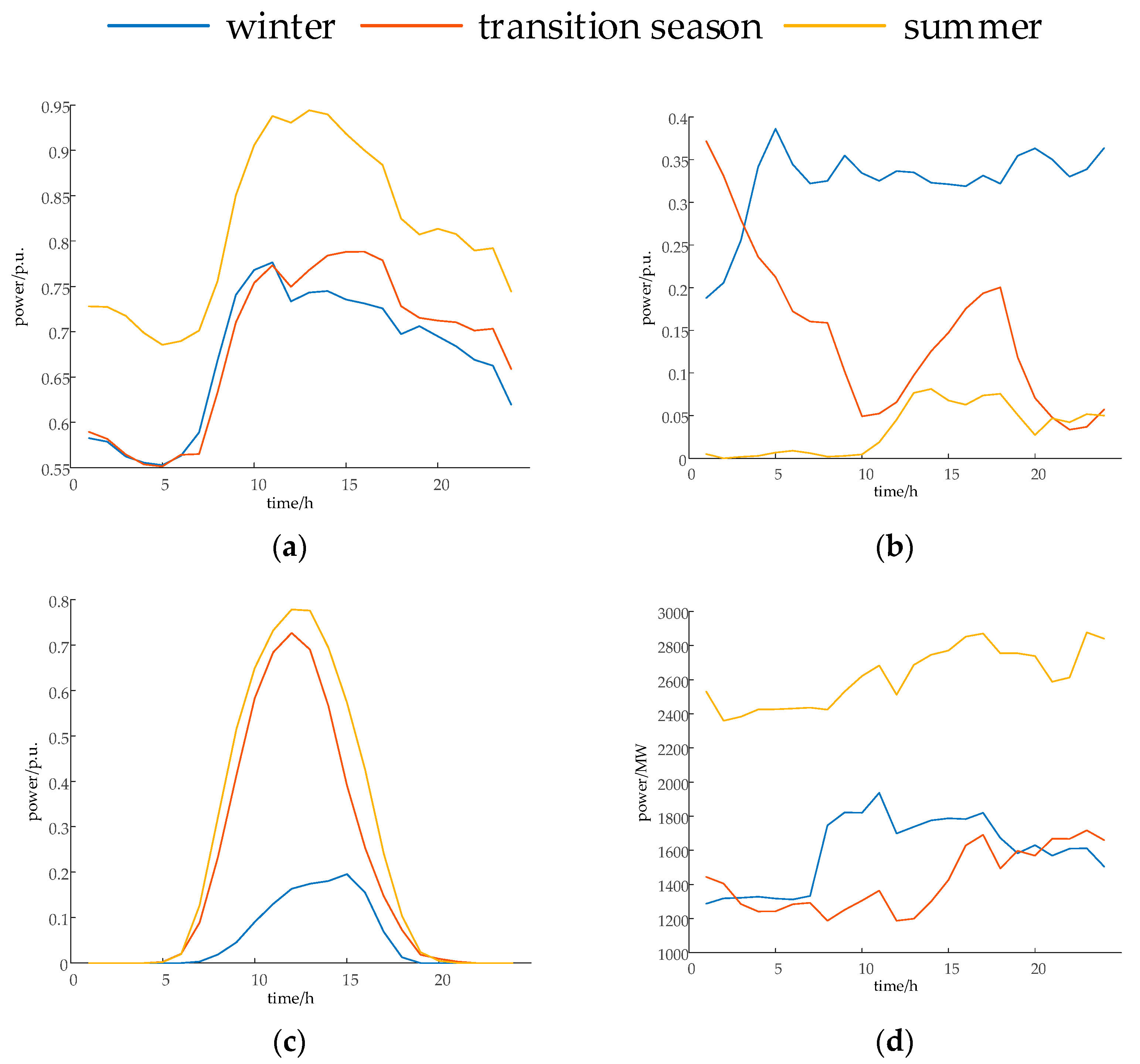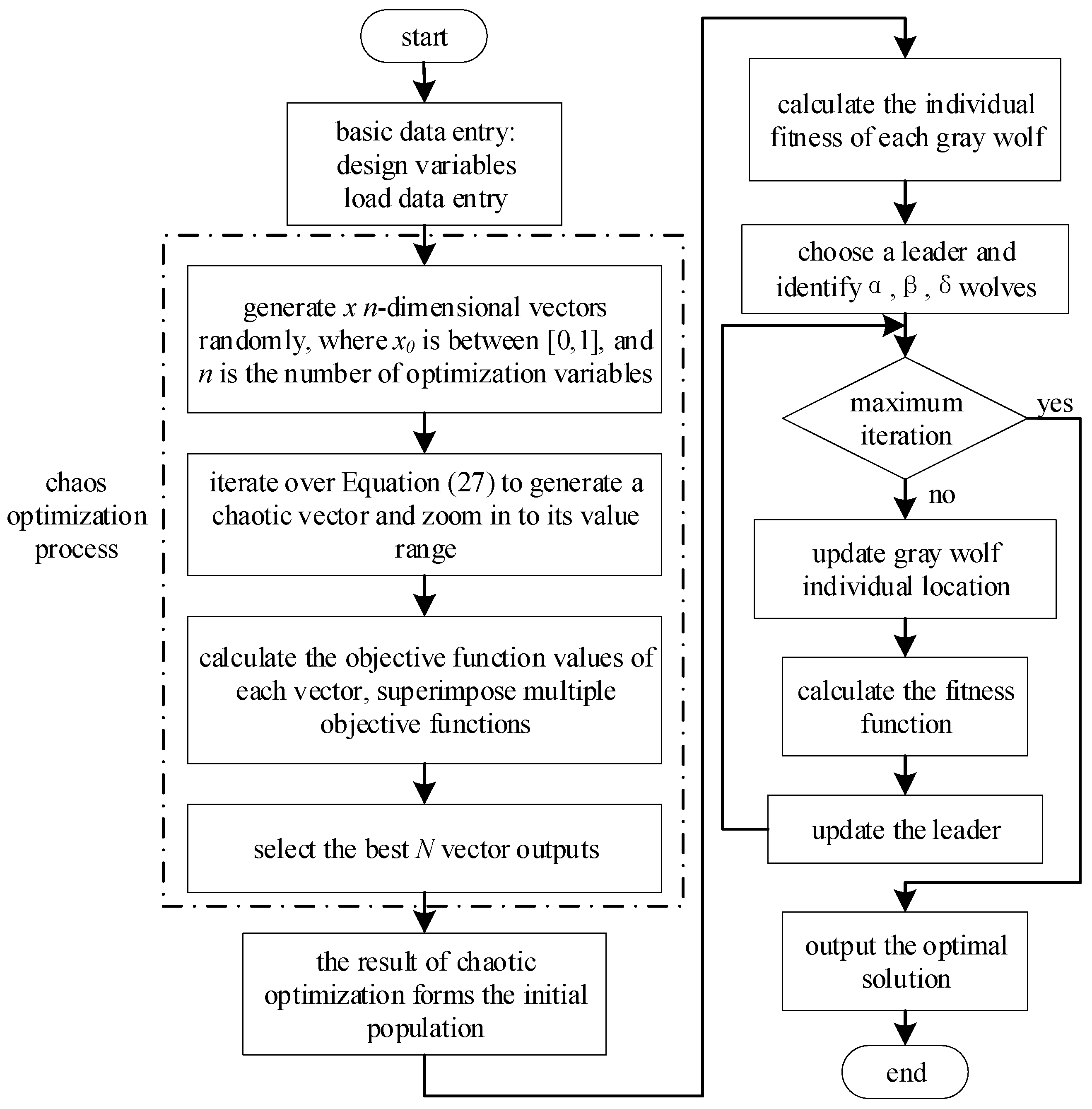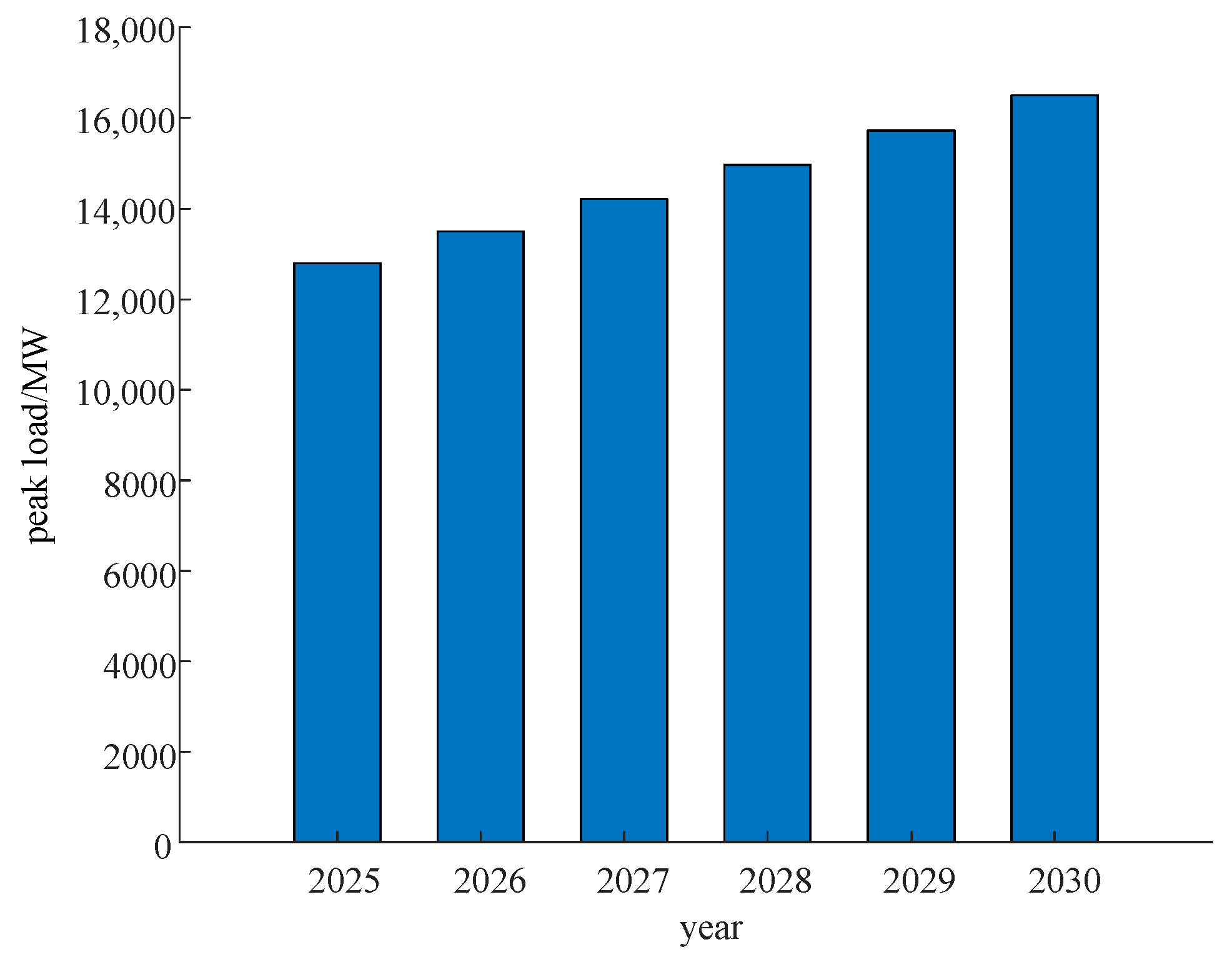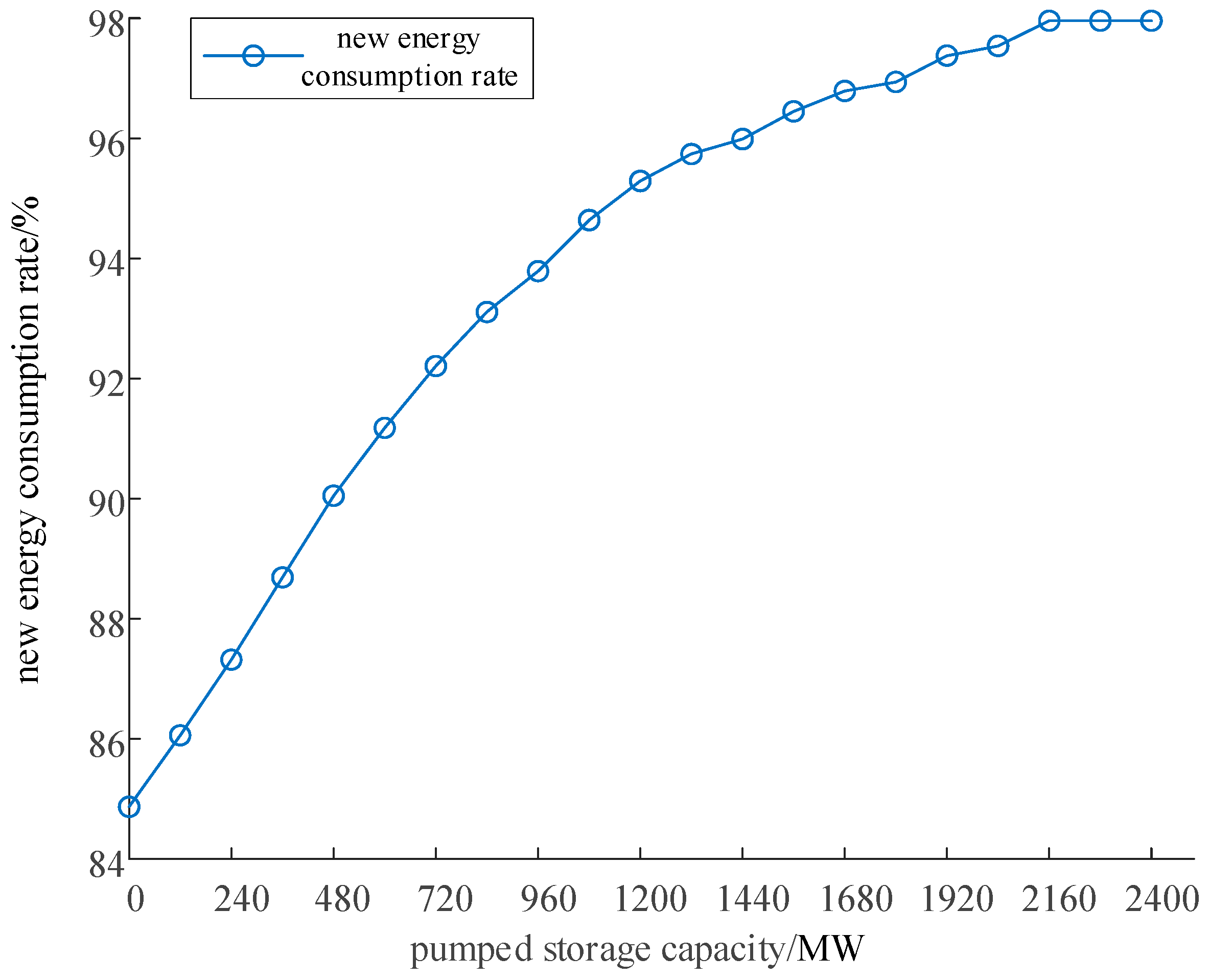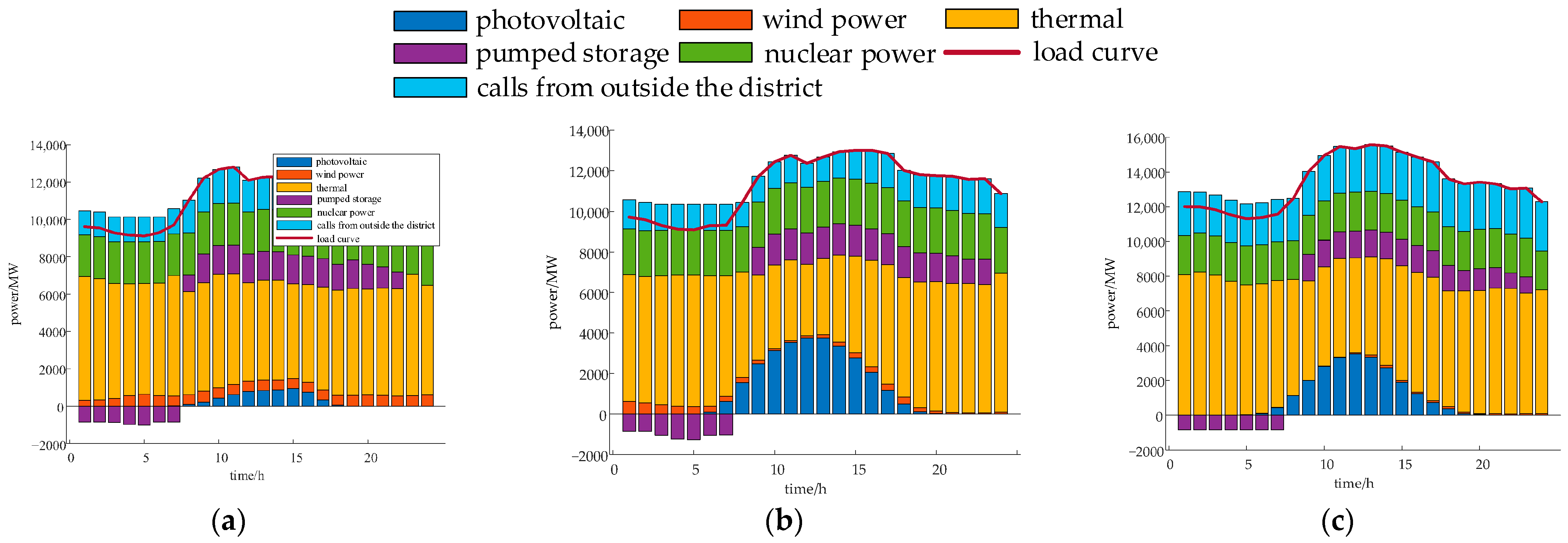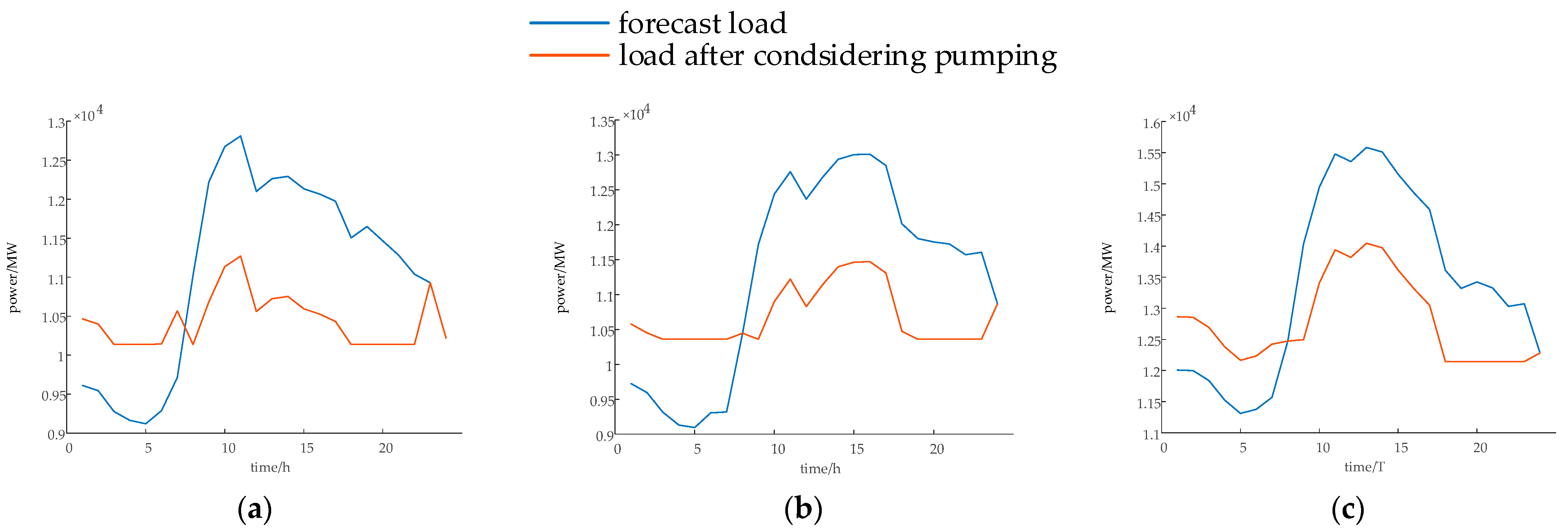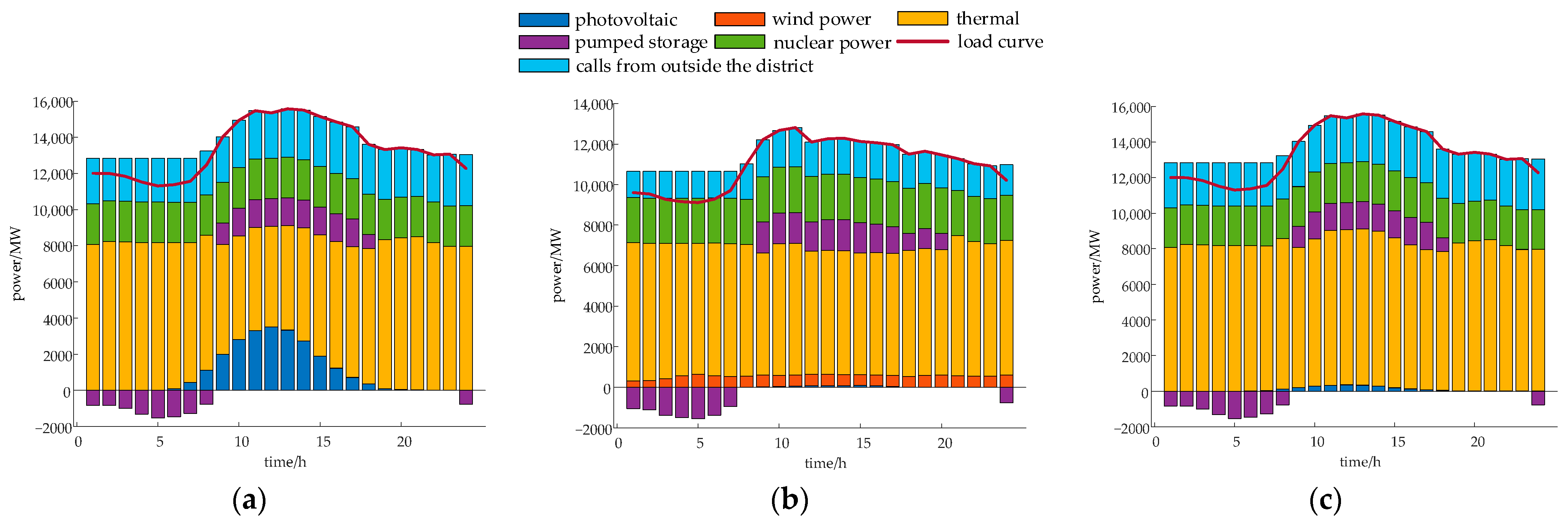1. Introduction
Against the backdrop of increasingly severe environmental challenges and the global transition in energy structure [
1,
2,
3], vigorously developing wind and solar power has become an effective pathway to achieve the “dual carbon” goals. However, the large-scale integration of renewable energy into the grid introduces significant threats to power system stability due to the intermittency and volatility of wind and photovoltaic generation, necessitating additional balancing power capacity [
4,
5]. Notably, prioritizing the accommodation of wind and solar power may reduce the operational flexibility of conventional power sources (e.g., thermal power) within the grid and exacerbate output volatility in these sources [
6,
7,
8,
9].
As a technically mature and economical power source for safe regulation, pumped storage can effectively improve the anti-peak regulation characteristics generated by large-scale wind power grid connection, play a role in peak shaving and valley filling [
10,
11] and help large-scale renewable energy consumption and reduce wind and solar curtailment in addition to ensuring the safe and stable operation of the power system [
12,
13,
14].
In the context of new energy consumption, scholars at home and abroad have carried out some research on the allocation and optimal scheduling of pumped storage. In Ref. [
15], a multi-time scale iterative optimal allocation model of pumped storage capacity was established, and the optimal allocation of pumped storage capacity was obtained by taking into account the investment and system operation costs. In Ref. [
16], a multi-objective optimization model was constructed to evaluate the joint operation benefits of different pumped storage capacity allocation schemes through the dual factors of maximizing economic benefits and minimizing output fluctuations, and finally selected the optimal scheduling strategy. From the perspectives of economy and environment, a capacity allocation model of pumped storage power station was established in Ref. [
17], which maximized economic benefits and environmental value while reducing wind and solar curtailment. On the basis of the wind-solar hybrid power generation system, a pumped storage capacity optimization model with the goal of maximizing the annual comprehensive income was constructed in Ref. [
18]. By introducing the swarm intelligence optimization algorithm of adaptive mutation mechanism, the optimal energy storage system configuration scheme is solved. In Ref. [
19], in the capacity optimization of the wind-solar-pumped-storage hybrid system, the dynamic regulation characteristics of the pumped storage unit are investigated, and the decision-making model of the installed capacity of the system is established based on the matching degree analysis of the power output curve and the power load. The existing research mainly focuses on the synergistic effect of pumped storage and renewable energy, but thermal power still dominates the real power system, so the coordinated operation mechanism of pumped storage units and traditional thermal power units also needs to be included in the scope of research. Ref. [
20] combines pumped storage and thermal power units, considers the invocation benefits of pumped storage and thermal power depth peak regulation, proposes an optimal scheduling model for pumped storage and thermal power peak regulation, and verifies that the scheme can greatly improve the economy.
Currently, there is still very little research on the capacity allocation of pumped storage power stations considering development timing. In Ref. [
21], a balance analysis model of the power system with carbon constraints was established, and the annual time series simulation method (8760 h) was used to empirically evaluate the specific contribution of pumped storage power stations to improving the renewable energy acceptance capacity of regional power grids.
The traditional pumped storage capacity allocation adopts a static target year planning method, which leads to insufficient capacity in the early planning stage, resulting in a large amount of wind and solar abandonment, and excess capacity in the later stage of planning, resulting in idle and wasted resources. Although the existing literature has made progress in the collaborative optimization of pumped storage and renewable energy, there are still significant limitations, mainly because the current models predominantly employ single-layer optimization that fails to capture operational feedback loops. These defects are manifested in the actual system as high early abandonment rate and saturation of resource utilization in the later stage, and a dynamic timing configuration framework is urgently needed to match the gradual development of new energy and load. In order to solve the above problems, this paper proposes a two-layer dynamic timing configuration model, the core innovation of which lies in the timing synchronization mechanism and the two-layer optimization architecture. The upper model aims to minimize the amount of power abandoned and generates a pumped storage capacity plan. The lower model performs multi-scenario economic scheduling, considers the peak-valley difference index and the two-stage electricity price return, and uses the improved Logistic-Tent composite chaos mapping gray wolf optimization algorithm to solve the multi-objective problem. The two-layer model realizes collaborative optimization through iterative feedback: the lower layer feeds back the actual abandoned power to the upper layer for capacity correction until the predicted abandonment is basically the same as the actual abandonment, or the capacity change tends to be stable, and finally outputs the optimal temporal capacity scheme. The simulation analysis of a provincial power grid in three typical daily scenarios and extreme weather scenarios shows that the timing allocation scheme significantly improves the early renewable energy consumption rate and eliminates the risk of resource idle in the later stage. Compared with the traditional single-layer model, the optimization scheme reduces the investment cost by 10%, improves scheduling economy, and reduces the peak-to-valley difference. In extreme weather scenarios, the model maintains robustness, confirming its adaptability in high-volatility systems. The main contribution of this paper are as follows:
A dynamic configuration timeline mechanism is created to solve the dilemma of misallocation of pumped storage timing resources through a stepped capacity accumulation strategy, and achieve a leap in full-cycle investment efficiency;
A two-layer model is constructed to dynamically calibrate the configuration scheme with the power abandonment rate feedback closed-loop to achieve more accurate allocation of effective regulation capabilities, and the model can still generate a reasonable scheduling scheme in extreme weather scenarios, which has a certain degree of robustness.
2. Pumped Storage Capacity Configuration Method Considering Construction Timeline
In this paper, the pumped storage capacity configuration and the load growth are carried out simultaneously, and the schematic diagram of the pumped storage capacity configuration, considering the construction timing, is shown in
Figure 1.
This paper studies the annual configuration of pumped storage power stations in a provincial power grid from 2026 to 2030. The load level is the predicted peak load of the current year, as described in the green load curve in
Figure 1.
The capacity configuration idea of pumped storage power station considering the construction timing is as follows:
The set
P, a capacity timeline vector, represents the set of new capacity added year by year from 2026 to 2030:
where
represents the incremental set of pumped storage capacity configured in the
ith year of planning; while
denotes the cumulative operational capacity.
As shown in the lower part of
Figure 1, firstly, the configuration
is planned to meet the load demand of the first year; in addition, the allocation
is planned on the basis of
to meet the demand of the second year under the load growth; and so on, the configuration
is planned on the basis of the configured capacity set
to meet the load demand in year
i, and the configuration
is planned in year 5, i.e., in 2030.
Figure 1 reveals the core concept of the dynamic expansion mechanism proposed in this paper, which employs a ‘stepwise’ capacity accumulation strategy to ensure that the newly added capacity each year precisely matches the growth in load. Initially, a high cost-performance ratio capacity is prioritized to alleviate the bottleneck in renewable energy absorption; subsequently, a moderate slowdown is implemented to prevent overinvestment.
3. Two-Layer Optimal Configuration Model
The basic idea of the dual-layer and layer-by-layer refinement optimization configuration algorithm is shown in
Figure 2. The upper layer provides a plan for pumped storage capacity based on capacity balancing, while the lower layer optimizes and schedules the system’s operation, feeding back the actual amount of curtailed electricity to the upper layer for verification and correction. The upper layer verifies the feedback values according to preset criteria; if the actual curtailed electricity exceeds the upper layer’s forecast, it determines that there is insufficient capacity and increases the capacity configuration. Conversely, if the actual curtailed electricity is significantly lower than the upper layer’s forecast, it determines that there is surplus capacity and decreases the capacity configuration. This process continues until the curtailed electricity forecast calculated by the upper layer based on its capacity plan is essentially consistent with the actual curtailed electricity achieved in the lower layer’s operations, or until the changes in capacity corrected by the upper layer between two successive iterations are minimal, thus yielding the final pumped storage capacity timeline.
The outer layer outputs the energy storage capacity and power to the inner layer for solving, and the inner layer calculates the corresponding charge and discharge power according to the given parameters, calculates the adaptation value and returns to the outer layer. Since it is difficult for the model to obtain an absolute optimal solution, this paper considers that the optimal solution can be reached by setting a certain number of cycles of the double-layer model.
3.1. Upper-Layer Model
3.1.1. Objective Function
The objective function of the upper layer optimization model is the minimum sum of curtailment of wind and solar power in the system, so as to determine the pumped storage power station capacity required by the system. The objective function is expressed as follows:
where
represents the sum of curtailment power of wind and photovoltaic in the system;
and
are the curtailment of wind and photovoltaic power;
and
are the available power of wind and photovoltaic; and
and
are the actual output power of wind and photovoltaic.
To maximize the regulation effect of pumped storage, pumped storage uses full power to pump water during low load periods. Therefore, the pumping power of pumped storage during low load periods is equal to its rated power, specifically expressed as follows:
where
represents the load;
represents the pumping power of the pumped storage unit; and
represents the low load period.
3.1.2. Constraint Condition
where
and
represent the upper and lower limits of the output power of the thermal power unit;
is a Boolean variable that indicates whether the units of the thermal power plant are in working condition;
represents the output power of the thermal power unit.
where
is a Boolean variable that indicates whether there is a change in the start-stop state of the thermal power unit; and
represents the initial start-stop state of the thermal power unit.
where
and
represent the ramp-up rate and ramp-down rate of the thermal power unit.
3.2. Lower-Layer Model
3.2.1. Objective Function
where
represents the cost of the grid operator;
represents the operating cost of the thermal power plant; and
represents the curtailment cost of wind and solar power.
Specifically, the cost of each component includes
In the grid optimization problem, the grid operator pays the thermal power plant the cost of power generation, including the cost of thermal power generation and the cost of starting and stopping.
where
represents the cost of thermal power generation;
represents the start-stop cost, and
a,
b, and
c are the cost parameters, which are the cost of a single start-stop.
The cost of curtailment is directly proportional to the amount of curtailment in the grid.
where
represents the probability of occurrence in scenario
s;
represents the amount of curtailment of wind and solar power in scenario
s; and
represents the curtailment penalty in scenario
s.
- 2.
Maximize pumped storage two-part tariff revenue as follows:
where
represents the income of the two-part electricity price of pumped storage;
represents the income of the electricity price of pumped storage;
represents the income of pumped storage capacity tariff;
,
, and
indicate the pumped storage feed-in tariff, respectively, pumped hydro power price and capacity electricity price, of which the feed-in tariff is the benchmark electricity price for coal, and the pumped hydropower price is 75% of the benchmark electricity price;
represents the generation power of the pumped storage unit; and
is the total installed capacity of pumped storage power station.
- 3.
Minimize load curve peak-valley difference:
where
represents the peak-to-valley difference in the grid load curve is described;
represents the highest load of the power grid in a day; and
represents the lowest load of the power grid in a day.
3.2.2. Power Balance Constraints
where
represents the nuclear power output.
3.2.3. Pumped Storage Unit Constraints
The same pumped storage unit can only operate in a single mode, that is, it cannot work in the pumped state and the power generation state at the same time:
where
is a Boolean variable that indicates whether the pumped storage unit is in the power generation condition, and the Boolean variable
indicates whether the pumped storage unit is in the pumping condition.
- 2.
Storage capacity constraints.
where
and
represent the maximum and minimum values of the reservoir capacity of the upper reservoir of the pumped storage power station;
represents the reservoir capacity of the upper reservoir;
and
represent the maximum and minimum values of the reservoir capacity of the lower reservoir of the pumped storage power station;
represents the reservoir capacity of the lower reservoir; and
and
represent the water consumption of the pumped storage unit under the power generation and pumping conditions.
In addition, there are constraints regarding conventional units and wind-solar hybrid units, which have been mentioned earlier and will not be elaborated upon here.
3.3. Model Solving
This article constructs a two-layer iterative optimization architecture, where the upper configuration layer addresses single-objective optimization problems with multiple constraints, utilizing the YALMIP toolbox to call the Gurobi solver. The Gurobi solver enables precise convergence control for the upper-layer model via its advanced branch-and-bound algorithm, delivering rapid convergence speed and enhanced robustness in linear problem solving. The lower execution layer resolves complex decision-making issues with multiple objective constraints. In order to effectively solve the hierarchical optimization problem, an improved grey wolf optimization algorithm with Logistic-Tent composite chaos mapping is innovatively proposed. In the field of multi-objective optimization, heuristic methods such as genetic algorithm and particle swarm optimization are commonly used, but these algorithms are easily troubled by local extremum. As an emerging swarm intelligence optimization technology, the Grey Wolf Optimization (GWO) algorithm has attracted much attention because of its concise parameters, no need for gradient information, and excellent global search capabilities [
22]. The algorithm innovatively constructs a search mechanism based on social levels: the optimal, sub-optimal and third optimal solutions are mapped into three leadership levels: α, β and δ, respectively, and the rest of the search individuals are used as followers. By simulating the cooperative hunting strategy of wolves, GWO realizes an intelligent search mode guided by the leadership level and coordinated by followers, which significantly improves the global optimization performance.
The standard GWO algorithm has obvious random distribution characteristics in the initial population generation stage, and the solution space coverage is insufficient, which may lead to the reduction in search efficiency. Chaos mapping can generate a more uniformly distributed and regular initial population in the search space, so as to enhance the global search ability of the algorithm, avoid falling into local optimum, and improve the convergence speed and optimization accuracy. By combining chaotic optimization, the optimization performance of the GWO algorithm is significantly improved [
18]. The more common chaotic maps include logistic mapping and tent mapping, which are relatively simple in mathematical form [
23], have high stability in numerical calculation, and are not prone to computational errors, but are sensitive to parameters and prone to window effects. The tent map is evenly distributed and has strong ergodability, but it may be periodically degraded. Therefore, in this paper, the two are used together, and the improved Logistic-Tent composite chaos map is as follows:
where
is the position of the gray wolf after the
mth iteration; ⨁ represents the XOR operations, improving the randomness and anti-truncation ability of sequences, and enhancing ergodability.
Map the initial decision variable
to a chaotic variable
between 0~1:
where
and
are the upper and lower limits of the search for the
jth dimensional variable.
According to Equation (27), the next iteration chaotic variable
is calculated, and it is transformed into a new decision variable
according to Equation (28):
The fitness value of the new solution is calculated based on the decision variable .
Figure 3 shows the flow of the GWO algorithm based on Logistic mapping chaos optimization.
5. Conclusions
This article addresses the common issues of temporal resource misallocation caused by the static configuration methods of target year capacity planning in traditional pumped storage systems, which often lead to a shortage of capacity in the early stages and waste due to capacity saturation in later periods. An innovative two-level planning model for the temporal configuration of pumped storage capacity that considers operational scheduling is proposed. The upper model aims to minimize the abandonment of wind and solar power generation and determines an approximate pumped storage capacity. Based on this, the lower model seeks to optimize economic benefits while considering the peak-to-valley difference in the load curve, utilizing an improved grey wolf algorithm for scheduling optimization. The actual amount of curtailed electricity is fed back to the upper model for verification and dynamic adjustment until the predicted curtailed electricity calculated based on the upper model’s capacity scheme aligns closely with the amount curtailed in actual operation from the lower model, or the changes in capacity correction in the upper model between consecutive iterations are minimal, ultimately resulting in a temporal configuration scheme for pumped storage capacity. The effectiveness and advantages of this method are validated through numerical examples, leading to the following conclusions:
The configuration of pumped storage in the system shows a saturation effect in promoting the absorption of new energy, necessitating a reasonable arrangement of the construction schedule. Specifically, the renewable energy absorption rate plateaus at 98.02% when the pumped storage capacity reaches 2160 MW, indicating diminishing returns beyond this point.
With the development of new energy and load, the temporal allocation scheme proposed in this paper significantly improves the absorption rate of new energy in the early planning stage compared to traditional target-year configurations, effectively alleviating the issues caused by early wind and solar curtailment; in the later planning stage, it avoids premature saturation of capacity, achieving the same high absorption rate as traditional target-year configurations while mitigating the risk of resource idleness, thereby realizing an optimized balance of resource efficiency and absorption objectives throughout the entire planning cycle, and enhances sustainability through optimized investment allocation and efficient resource utilization. Specifically, in the early-stage year of 2026, the proposed timeline scheme will improve the consumption rate from 90.81% to 95.30%, reducing curtailment significantly; while in the later stage year of 2030, both scenarios will achieve 98.02% absorption rates, but the timeline scheme reduces cumulative capacity by 10%, avoiding overinvestment and idle resources.
The two-layer optimization planning method employed in this article demonstrates a higher solution efficiency compared to single-layer models, and the refined allocation of pumped storage capacity outperforms the single-layer model in terms of economic viability and system operational stability indicators. Concretely, the total cost of the two-layer model is 1.57 and 1.03 million CNY lower than that of the single-layer model on typical days in winter and transition season, respectively, and the peak-valley difference in the equivalent load of the two-layer model decreased by 18.3%, 23.2%, and 10.7%, respectively, under the three typical days.
In extreme weather scenarios, the model proposed in this paper is still capable of generating effective scheduling solutions, which verifies the robustness of the model in dealing with complex and uncertain situations.
The timing capacity allocation method established in this paper provides a generalizable implementation path for provincial energy decision-making: power grid planners can achieve precise investment and effectively solve the planning dilemma of “insufficient capacity in the early stage and idle resources in the later stage”. When it is promoted to areas with mature pumped storage regulation systems, it can effectively promote the cross-regional consumption of new energy by coordinating the mutual assistance between provincial peaks and valleys. In provinces with significant fluctuations in electricity consumption, the expansion rhythm can be customized based on local load characteristics, taking into account system safety and investment benefits.
In this stage, the impact of prediction errors such as load and wind and solar uncertainty has not been fully studied, and the sensitivity analysis of key factors such as wind speed will be quantified according to the research progress in the future. At the same time, a life-cycle cost–benefit framework that takes into account social and environmental indicators will be introduced to establish a more comprehensive evaluation system for pumped storage.
